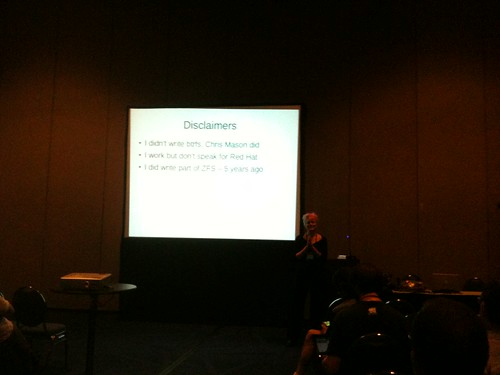As Tim says, one never has trouble finding an interesting conversation at OSCON. Which is part of the problem.
In the first session alone, there were six, count them, six sessions that I would have liked to attend. Val Aurora’s talk on Btrfs, Bradey Kuhn’s session entitled “With Software as a Service, Is Only the Network Luddite Free?,” cameos from Canonical and Intel on UbuntuOne and Moblin, respectively, lessons from Six Apart on Memcached, and Jono Bacon’s – he of the very well reviewed Community Leadership Summit – “Building Belonging.” And that was just the first session. As it turned out, I hit Val’s filesystem talk…for about fifteen minutes, because I’d managed to schedule myself ahead of time an interesting conversation at 11 AM.
C’est la OSCON.
As much as the content, both hallway and in-session, shined – I’d respectfully disagree with Masood Mortazavi’s comment related here – this OSCON had a considerably different feel to it than in years past. Which is not surprising, given that the venue had shifted some 667 miles to the south. My understanding was that the selection of San Jose was made in part as a reaction to the recession; the Bay Area having the highest population density of geeks probably on the planet, more would be able to attend at a lower cost. Or so the thinking went.
And to some extent, this was proven true. While I missed Jono’s session, as mentioned above, according to reports better than 60% of the room raised their hands when asked if they were attending for the first time. So kudos to O’Reilly for engaging new audiences even in a down economy, even while I lament the loss of Pacific Northwesterners who couldn’t make the trek like Friend of RedMonk Donnie Berkholz.
That said, San Jose lacks the charm of fake Portland, and while the latter’s convention center is nothing to write home about, it has a better feel – and unquestionably better seating options – than did its Californian competitor. Between the seating and the sheer size – I nearly missed a meeting with the Eucalyptus folks because of the distance between the inexplicably separated media and speaker’s rooms (.25 mile) – the San Jose Convention center was an inhibitor rather than a catalyst for the traditional OSCON hallway track. It didn’t throttle it completely, of course – no venue has that power. But at least anecdotally, I both participated in and witnessed far fewer ad hoc interactions than in years past.
Which is maybe correctable, and maybe not. Either way, if I had a vote, I would return to fake Portland over San Jose seven days a week and twice on Sunday. As I don’t have a vote, I’ll wait and watch and, in all likelihood, attend next year’s version wherever they choose to hold it.
Beyond the conference logistics is the content: what’s the zeitgeist of the open source world these days. Here are a few of the things I talked about or heard.
Analytics
You might think that my enthusiasm about the subject of analytics is unduly influenced by the fact that the briefing I received from the REvolution gang at the show included not just baseball data, but a statistical analysis of a player I’ve written rather extensively about myself, and you might be right.
And yet I remain convinced that analytics as a category is about to jump. While the space is hardly new – BI suites are decades old at this point and open source has credible projects in the space (BIRT, Jaspersoft, etc) – there’s a lot of room left for innovation. I’ve already written about the data that we’re all generating; the next step will be demystifying the process of leveraging that data for actionable insights.
David Ascher, CEO of Mozilla Messaging, talked about this with me for a few minutes at the show, demoing a little Jetpack derived plugin for Thunderbird that provided some simple – yet personally powerful – metrics about email usage and consumption. These are the types of insights we’ll be seeing more of in the future, thanks in part to the efforts of open source to scratch individual itches when it comes to personal – and by extension – professional metrics.
Cloud
For two technical trends that have occasionally been at odds with one another, there was a great deal of cloud discussion at OSCON. It’s not particularly debateable that open source projects do now and will continue to play a crucial role in cloud infrastructures. What is less apparent is to what degree the openess of the software will equate to the openness of the cloud, an unattractive prospect to many if not most of the attendees.
Open source was able to disrupt the world of enterprise software via a variety of mechanisms, from the distribution advantages to reciprocal licensing provisions to lower barriers to entry. But besides being largely immune to one of those advantages – the reciprocal licensing provision (one attendee predicted more uptake of the AGPL in response, and Launchpad at least validated this assertion) – cloud computing enjoys protections that enterprise software never did: economies of scale.
It’s far more difficult to see open source alone disrupting a major cloud player as it has to various enterprise software players, if only for that reason. But contrary to reports that I’ve written open source’s obituary at the hands of the cloud, I actually see an important future for it. But more on that later.
Data Persistence
Maybe James is right and we here at RedMonk should change our tagline from “Analysis for the people, by the people,” to “We can tell you what will happen…we just can’t tell you when.” At least it felt like that at OSCON this year when I looked around and saw a veritable explosion of talks on non-relational datastores. Back in 2005, in a piece entitled “Three Predictions: Languages, Databases, and Collaboration,” I said the following:
Over the past few decades, persisting data for the applications that needed it meant a relational database. Sure, the names may have changed and vendors may have risen and fallen, and there was an exception or two such as Sleepycat’s Berkley DB, but pretty much universally when people talk data persistence they mean ‘relational database.’…
But I’ve been hearing a bit more grumbling lately (due perhaps to the invasion of simplicity elsewhere in the dev lifecycle?) from the development community that relational databases may not in fact be the answer to every problem. Many of them, perhaps, but not every problem. What are some of the shortcomings? Well, I’ve been recommending that everyone take a look at what Google’s Adam Bosworth had to say in a blog entry here and a Gillmor Gang session here. It is startling, when you take a step back, at how difficult it is to use relational databases to solve non-trivial problems.
…
Whatever the technical basis, I think developers are beginning to loosen the relational shackles just a bit, to the point that they’re permitted to at least explore other technical options. Whether they’re XML, object-oriented or just really sophisticated filesystems is ultimately besides the point – it’s the fact they are actually meriting longer looks that matters. From a developer’s perspective, it’s about projects that can choose the technology that works best for their needs. Maybe that’s relational, but maybe it’s not. Been a while since many have had that choice, and it’ll be fascinating to see what people do with that freedom.
And while the above predates (as far as I’m aware) the development of Cassandra, Drizzle, Hadoop, HBase, HyperTable, MongoDB, Tokyo Cabinet, and Voldemort, the credit for the above really belongs with Adam Bosworth who was first writing about the problem way back in 2004.
Here we are, though, all these years later, and what was predicted has come to pass: a variety of non-relational projects are emerging. Not to replace relational databases, generally, but to complement them. Much as MySQL targeted workloads not generally being served by the likes of DB2 and Oracle, so too are we seeing a variety of non-relational stores emerge to tackle new challenges. NoSQL notwithstanding – I think Eric Florenzano’s “different tools for different jobs” message is exactly right – we’re not likely to see a SQL dominated environment replaced wholesale by non-SQL alternatives; I wouldn’t hold your breath for Oracle to Tokyo Cabinet swapouts for SAP installations, in other words. But we will see – are already, in fact – is the deployment of projects like Cassandra, CouchDB, Drizzle, Hadoop and Voldemort in non-traditional settings.
OSCON, predictably, reflected this growing reality, with sessions on topics like Paul Brown’s Vodemort-based Twitter Clone leading the way (missed it, sadly). It’s too early to say which if any of the current crop of projects will grow to MySQL or PostgreSQL like popularity (though Mark Callaghan’s Drizzle comments are interesting, all the more so since his transition to Facebook), but they’re here and they are not going away.
So while I may have been a wee bit early with predictions of data layer diversity, I’m counting it as a hit.
Party
All work and no play making sog a dull analyst and all that, we – Cote and James were happily colocated in San Jose for the Adobe analyst conference – were delighted to host a small OSCON gathering, as has been the tradition. Wednesday night, Josh Berkus, Jennifer Cloer, Danese Cooper, Sara Dornsife, Glynn Foster, Joe Gregorio, Jeff Jones, Dave Neary and a bunch of other people I’m forgetting about collected at O’Flaherty’s Irish Pub for a few hours of drinks and catching up.
It’s become one of OSCON’s more critical functions, I’ve found: there are people I literally see only at this event every year, and while remote collaboration is all well and good, it’s nice to have a beer with people every so often.


